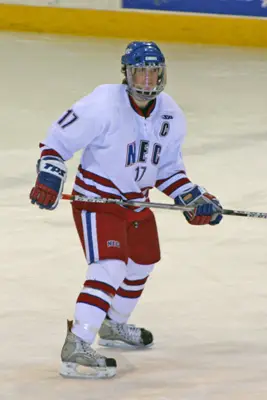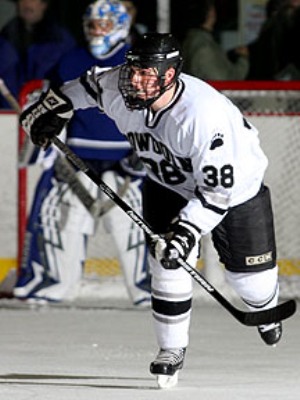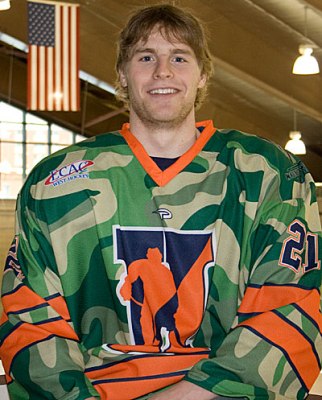Happy Valentine’s Day!
Enthusiasm? About Valentine’s Day? From this girl reporter?
Over the years, I’ve made it clear that Valentine’s Day is every bitter, divorced, middle-aged hockey writer’s least favorite holiday … and yet already I’ve broken with personal conviction and mentioned the Hallmark holiday by name three times in this column.
I sense your confusion. You’re thinking, Has she found true love (other than Steve Cady Arena)? You’re thinking, Has she misplaced her copies of Avalon and Surfacing? You’re thinking, has she escaped the semi-winter of central Ohio for someplace of sunnier disposition?
And I know that you’re aware that Mercury remains retrograde until Monday.
Rest assured, my CCHA pals, that I have not found true love, that I will indeed wallow in Roxy Music and Sarah McLachlan at some point this weekend to celebrate this manufactured holiday in a way that befits it most, and that I’m still mired in Columbus.
And I’m still bitter, single, and another year closer to that membership in AARP.
Bitter and divorced, but perhaps not as unrequited as years past. Michigan and Miami may have exchanged places in the PairWise and the poll, but they are still Nos. 1 and 2. Michigan State — still very much in the NCAA hunt in spite of two losses last weekend — is still the defending national champion. And Notre Dame is in the mix.
The English poet Elizabeth Barrett Browning once said, “Whoso loves believes the impossible.”
I believe that the CCHA has as good a shot as any conference at another national title this year.
How’s that for love?
Ryan Jones, The New Fabio
No, I’m not saying that Jones should chuck his hockey career and become a bodice-buster cover model. Nor am I suggesting that Fabio would lay the kind of give-the-opponent-the-lead-within-the-first minute hit that Jones did last Saturday when the RedHawks played the Wolverines.
It’s the flowing locks. I haven’t had hockey-hair envy like this since Ryan Jestadt graced the Ohio State roster.
Um, but back to that hit thingy that I mentioned. Actually, it was a penalty for high sticking 19 minutes into the game, which led directly to Travis Turnbull’s goal from Brandon Baurato at 1:08 to give the Wolverines the early 1-0 lead.
The significance of this goal cannot be understated. After losing 4-2 in their own barn to the Wolverines the night before, the RedHawks undoubtedly wanted to make a statement from the opening drop of the puck. Certainly, captain Ryan Jones was just the man to fire up his squad.
But statement made was of the wrong kind. I’ve said before that I love Jones’ brand of dirty — that’s no slam — and I’m not going to fault a kid whose passionate play led to something genuinely fortuitous for the other guys.
However, that’s exactly what happened. Jones netted the first goal of the game for the ‘Hawks seven minutes later and Andy Miele — a midseason pick-up for Miami from the USHL’s Chicago Steel — made it 2-1 at 14:26.
The Wolverines opened the game up with three goals to Miami’s one in the second, added another power-play score at the 35-second mark of the third, and that RedHawks had to catch up two goals in the final 10 minutes to force the tie and earn their one little point in their own arena.
That early goal gave Michigan an edge for the remainder of the game. Yes, the RedHawks were leading 2-1 after one, but there was never a sense that they could or would run up a lead on Michigan the way the Wolverines had done on them the night before.
Oh, and here’s a note about Jones: He needs five more penalty minutes to reach 300 career minutes with Miami. When he does so — and it’s got to be when, not if — he’ll be the second player in Miami school history to hit the mark.
So Good to Be so Blue
Even though this is the feel-good Valentine’s Day of the decade for CCHA fans — at least for this CCHA fan — there’s room enough for the right kind of blue.
I’m talking about the Maize and Blue, of course.
For fans throughout the CCHA, Michigan is the New York Yankees: You love them if they’re yours, but you hate them if they’re not.
This makes sense to me only because I grew up a Red Sox fan. As I have no pony in this race, though, I’m perfectly, happily in love with the Michigan Wolverines.
And why not? Red Berenson, Mel Pearson, Billy Powers, and the rest of the UM staff make this look easy. Yes, you can argue that it’s easy to recruit to Michigan, that the Wolverines have many draft picks — blah, blah, blah. The recruiting advantage didn’t exist until Berenson took the reins and built an empire.
It’s Valentine’s Day. Don’t be a hater.
Watching Friday’s 4-2 Michigan win over Miami was a revelation. The Wolverines led 4-0 after one on goals by Louie Caporusso, Aaron Palushaj, Kevin Porter and Max Pacioretty.
That’s four freshman and one of two seniors, the team’s captain. The goals came within the span of six minutes in the middle of a period in which the Wolverines dominated every aspect of play.
Poor Jeff Zatkoff, the excellent Miami goaltender who had led the nation in save percentage and goals-against average until the games against Michigan, was left to fend nearly for himself as the Wolverine offense overwhelmed a RedHawk defense that’s so good that it’s still tops in the nation after giving up nine goals in two games.
Given the buzz Michigan’s performance created, it’s easy to forget the Wolverines’ record in their last six games: 1-1-4. The 4-2 win broke a four-game winless streak, the longest such stretch for UM since the 2005-06 season, when it happened twice.
That the Wolverines have registered just five, four-game winless streaks in this millennium is remarkable. And you have to go back to the 1998-99 season for a winless streak of more than four games.
In 2004-05, a four-game losing streak had Andrew Ebbett proclaiming, “This isn’t Michigan hockey!”
There was none of that this year. The Wolverines simply ventured into Steve Cady Arena for their first time ever, and beat the pants off the No. 1 team in the country.
And let’s not get overly dramatic now. The Wolverines are in first place in the CCHA, one point ahead of the RedHawks. With six regular-season games left, Miami has a real shot at a title, and even Michigan State — five points out of first place — is a mathematical possibility.
The RedHawks lost three points at home to the Wolverines, who haven’t lost yet on the road (10-0-2). “By no means is this the end of the season,” said Miami head coach Enrico Blasi after Saturday’s game. “We’re 25-4-1 — give me a break.”
The games were fast, fast, fast. Flipping back and forth Saturday night between the UM-Miami and OSU-UNO games, I was struck immediately by the difference in speed between the two contests. Watching both UM-Miami games was like watching two NCAA tourney contests.
Both goaltenders are outstanding, but Billy Sauer showed tremendous poise in Steve Cady Arena. On the road, Sauer is 9-0-2 with a .921 save percentage and 2.15 GAA.
Michigan and Miami may, in fact, have the two best offenses in the nation. This may not be a statistical anomaly. The Michigan freshmen are certainly no longer rookies, and Miami’s depth is impressive. Nathan Davis returned for the RedHawks to make them even deeper — he scored Saturday night — and Andy Miele has three goals in his six games with Miami, including two Saturday.
Max Pacioretty earned his ROTW honors. Wow.
I don’t think anyone is going to beat either of these teams before Detroit, so I’m definitely looking forward to March … and maybe even April.
Our Love Affair Is a Wondrous Thing
The hype that surrounded the Michigan-Miami series was impressive, within the confines of college hockey.
On Tuesday night, I was a guest on “The Pipeline Show,” with Dean Mallard and Guy Flaming on TEAM 1260 radio in Edmonton, Alberta. Somehow, Dean and Guy have convinced the good folks of that fair city that I’m an expert to be consulted about CCHA hockey. We have a good time every time I visit. We talk hockey, and there’s something about a “pants party.” I’m not lying.
Anyway, when I was on Tuesday night, Dean asked me about the attention paid to the Michigan-Miami match-up. He made an analogy to NCAA football, and referred to the BCS Bowl, another one-two punch.
He asked — and I’m paraphrasing here — “Is it like that?”
I love Canadians. I love that someone in Canada would ask, with all seriousness, if the meeting between Nos. 1 and 2 in college hockey receives the same attention as the meeting between Nos. 1 and 2 in college football.
I love that someone in Canada thinks that the meeting between Nos. 1 and 2 in college hockey receives as much attention as, say, Uno, the first beagle to win the Westminster Kennel Club Dog Show in the canine pageant’s 132-year history.
In the dictionary next to the word niche is Ron Mason’s picture.
Meow … .and Then Some
With all the hype (within the confines of college hockey) surrounding the UM-Miami series, it would be easy to overlook the most interesting thing that’s actually happened in the CCHA in the month of February.
It would be easy, that is, if you weren’t an old cat lady like me.
That the Northern Michigan Wildcats are 2-0-2 in their last four games is noteworthy; that they tied Michigan twice in Yost Arena and beat Michigan State twice at home to build that recent record is enough to make any ‘Cat fan purr.
“They’re two really, really good teams,” said head coach Walt Kyle. “We certainly caught some breaks in both series.”
The kinds of breaks that the Wildcats caught include “really good goaltending all four nights,” said Kyle, plus “a little bit more puck luck than them — they both hit a lot of posts.”
NMU had to come from behind in both 3-3 ties in the Michigan series, with freshman Mark Olver scoring the game-tying goal the first night, five-on-three, with 8:20 left in the third.
In the second Michigan game (Feb. 2), the Wildcats were down two goals midway through the second. Wolverine Chad Kolarik had made it 3-1 at 10:18 in the second, but Wildcat sophomore Matt Butcher stole the puck at the Michigan blue line seconds later, flew in two-on-one on UM goaltender Bryan Hogan and scored at 10:55 to make it 2-1. Junior Nick Sirota completed the comeback and forced the tie at 7:01 in the third.
Last weekend, the Wildcats outscored the Spartans 6-1 at home, with Sirota earning the hat trick in Friday’s 3-1 contest (but not earning POTW honors), and senior Matt Siddall scoring two Saturday. Olver also had a goal in Saturday’s 3-0 win.
Sophomore Brian Stewart had 55 saves against MSU, 74 the weekend before against UM.
“The guys worked really hard, there’s no question about that,” said Kyle. “When you’re playing teams with that kind of success, you have a lot of respect for them.”
It’s been a see-saw season for the Wildcats, who began their CCHA play with series against Michigan, Michigan State, and Miami. NMU went 0-6-0 in those contests, but since then has performed more than respectably since.
“We fell on our face the one weekend against Wayne State [Jan. 11-12],” said Kyle. “Other than that, we’ve played pretty well and consistent.”
The Wildcat team is young, dressing as many as 17 freshmen and sophomores per game. But solid goaltending and this season’s experience have combined to make this a formidable team down the stretch.
“Brian has emerged as our go-to guy,” said Kyle of Stewart, who came into his own in a first-round CCHA road playoff series against Ohio State last season.
“We don’t have a lot of guys in the junior and senior classes,” said Kyle. “Over the course of the year…we’ll play really, really well, then we’ll be way off. We’ll do that in the course of a game, or over the course of a couple of games.
“Some of our young guys, like TJ Miller, Alan Dorich, Ray Kaunisto … we had a big senior class last year, so those guys didn’t have a lot of minutes. Now they’re playing and playing well.”
Kyle said that the Wildcats have three goals for the remainder of the season. “Number one is to prepare, to be successful. And we want to get home ice, and finish as high as we can.
“We have to understand that we’re not where we want to be yet.”
The Wildcats are my Valentines this weekend (in the absence of Nate Guenin, of course). NMU will play OSU twice in the Schottenstein Center, a building where, says Kyle, “We haven’t had a lot of success.”
While the ‘Cats eliminated the Buckeyes last year in Columbus in the first round of the CCHA playoffs, they did so at the OSU Ice Arena. Those two wins were their first in my adopted hometown since 1981.
The Wildcats have yet to win at the Schott. As the Buckeyes have just two league wins on their home ice this season, the NMU may finally be requited in Columbus, at last.
Just Heartbreaking
All kidding aside, when a story like Kevin Quick’s comes to light, it’s heartbreaking.
In college hockey, we like to think that “our” kids are somehow a caliber apart from athletes in other sports. It’s a conceit that does little justice to any student-athletes, but that’s the way we are.
In Sunday’s Buffalo News, columnist Bucky Gleason reported that Quick — who had been dismissed from the UM squad for violation of team rules the week before — had stolen a credit card and used it to make thousands of dollars worth of purchases.
The Tuesday Michigan Daily repeated the allegations, adding that Quick hadn’t returned the Daily’s calls.
Both the story in the Daily and a story in the Ann Arbor News cited a Newport News Daily Press story in which Quick said he’d have to face some legal music back in Ann Arbor.
See how tricky this is? I don’t have any direct evidence of anything, and I’m not trying to malign the kid. All reports point to credit card issues.
Quick’s father, Kevin Sr., was quoted in the Buffalo News as saying his son had “made a mistake” and is “suffering the consequences.”
Quick himself told the Newport paper that he had “made a bad decision” that had “cost [him] a scholarship.”
Quick signed a tryout contract with the Tampa Bay Lightning’s AHL affiliate, the Norfolk Admirals, last Saturday. I don’t mean to be unnecessarily sarcastic, but that’s some consequence.
If it comes out that Quick’s transgressions were against teammates, the betrayal will feel enormous.
Love that February Hockey
And with six regular-season games remaining, the series to watch this weekend is Bowling Green at Nebraska-Omaha, played at the Mavericks’ beloved Civic Auditorium.
There’s a lovely history here between the teams, dating back to UNO’s first season as a full member of the CCHA. That was the year that the Mavericks beat the Falcons in a CCHA playoff play-in game (March 14, 2000) to advance to Joe Louis Arena, where they then beat up the Wolverines, 7-4, en route to a 6-0 loss to Michigan State in the league title game.
It’s all the stuff of Maverick hockey lore now, and since then UNO has had much success against BGSU. Last season, the Mavs went 6-0-0 against the Falcons, including a first-round CCHA playoff home sweep of BGSU.
The games this week are every bit as important as those that ended BG’s season last year. The Mavericks are two points ahead of the Falcons in league standings, but the Falcons have two games in hand on the Mavs. UNO is in fifth place, BGSU in sixth.
Nothing says love quite like a Falcons-Mavericks series, especially in the old Aud. And you thought a certain sliver of Maverick fans call themselves the Red Army because of their team’s colors.
Nah. It’s all about the love, baby.


